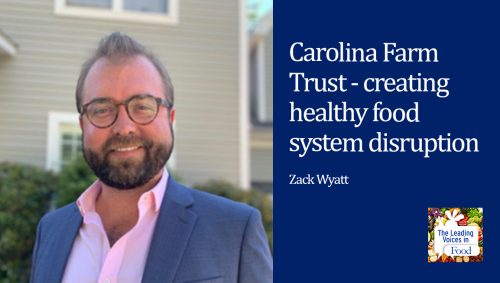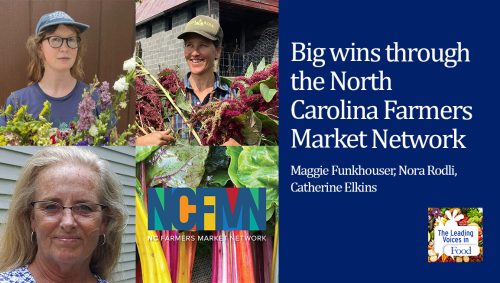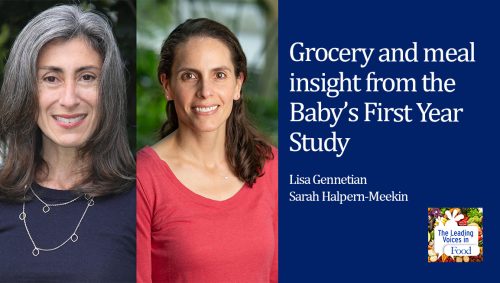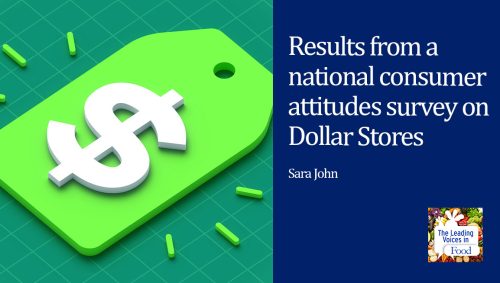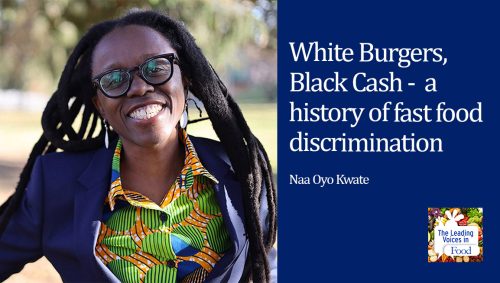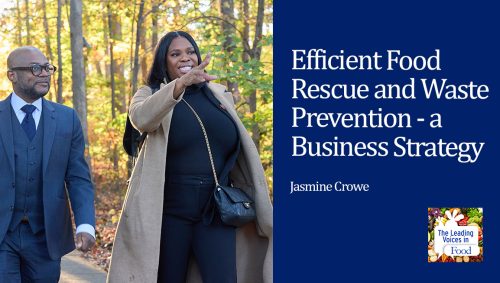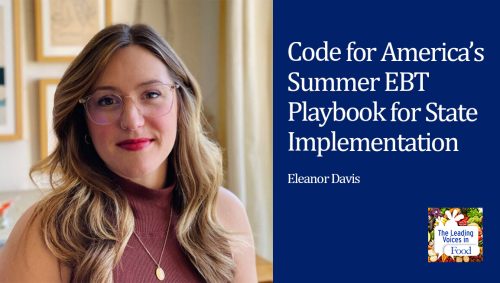E130: Can Software Help Cities Solve Food Insecurity?
Can software help urban planners tackle food access in big cities? The UrbanFootprint organization says yes. Fast Company named it one of the most innovative social good companies in 2021. Our guest today is the company’s co-founder and CEO, Joe DiStefano. He’s going to explain how city data and geospatial information can inform critical planning decisions about where to invest and to deploy resources to achieve urban food system resilience and to better support communities.
Subscribe: Apple Podcasts | TuneIN | Google Podcasts | SoundCloud | PocketCasts | Radio Public
Tags: Community & Economic Development | Diet & Nutrition | Equity, Race & Food Justice | Food Insecurity | Social Safety Net & Food |

Joe DiStefano is CEO and co-founder of UrbanFootprint, a software company that serves the world’s first Urban Intelligence Platform to public and private-sector organizations taking on the urban, climate, and social equity challenges of the 21st century. UrbanFootprint’s data and web-based geospatial software unifies previously siloed climate, environmental, urban, and socio-economic data and helps governments, utilities, financial institutions, and urban and transportation planners to answer fundamental resource questions—where to invest, where to deploy resources, and where to optimize for risk, return, resilience, and community. Before starting UrbanFootprint, Joe spent more than 20 years as a leading practitioner in the urban planning and disaster response field, working with governments and enterprises across the globe in designing cities and new technologies to tackle critical challenges in climate, land use, mobility, hazard risk, and social equity.
Interview Summary
So, let’s set the stage for our listeners. What is your view of the urban food insecurity problem?
Well, today, according to our data, about 19 and a half million, nearly 20 million households, are food insecure today, and that means they don’t have the financial resources to confidently put food on the table throughout a week or throughout a month. That is a growth of nearly 50% since March 2020, when the pandemic began. So, we had places that were already significantly food insecure, or households that were experiencing a lot of stress when it comes to food security before the pandemic, but this has been a pretty substantial uptick. In some of the hardest-hit states we’re looking at one in five households that are food insecure. I think even more troubling than that is that more than 12 million of these households report what we know of as food insufficiency, and this means not having enough food to eat at some point in the last week. So, some of these places, Mississippi, Louisiana, Texas, New Mexico, Oklahoma, those round out the top five right now according to our data. This is where 20% of households, and in some cases greater, are food insecure. What this striking number suggests is that existing relief programs and the existing kind of complex supply chain on the food insecurity side of things are not quite meeting the needs of some of the most vulnerable Americans.
You know, there’s been a lot of attention to food insecurity during COVID, and I sure hope that when COVID is in the rear view mirror, whenever that comes, that people don’t forget that it was a very significant problem to begin with. But boy, you make a good point about how it’s been even worse during the pandemic. So, how does the data and a geospatial software program help with this problem? Can you describe the platform that you’re building and tie that to the challenges that city planners and communities face?
Just as a really brief piece of background, so I spent about 20 years effectively playing SimCity for real; that was my job. Those of you who know that game, we did that for real, right? So, we were out there building data-oriented models of cities, and then experimenting with the impact of changes, so if you put housing here, or a transportation system here, what are the energy impacts, the water impacts, the health impacts. So, come COVID, we really oriented that data facility and that platform in the direction of some of these really challenging resource distribution issues, and this is not something I actually knew a lot about a year and a half ago.
We started doing work in Louisiana right about beginning of the COVID crisis with some folks that we had worked with in the post-Katrina, Rita recovery days in 2005, ’06, ’07, and one of the first things that we learned is that this COVID crisis is a very complex economic crisis. It was very unevenly distributed across communities, so in many cases poor Americans, non-white Americans were really adversely hit by economic impacts in particular. As those economic impacts started to unfurl on the landscape, we saw some very significant increases in need for things like food, very significant increases in eviction risk, very serious challenges around being able to get to test sites and medical facilities as transit systems that serve the most transit-dependent Americans turned off overnight, or dramatically reduced service. So, when we sat down with officials at federal, state agencies and relief providers in Louisiana, one of the first things we learned is that there was very substantial concern as to how to get basic needs like food to this increasing number of Americans that were needing it. So, we put our data systems to work to begin to understand that, so data that we have traditionally taken for granted as relatively static, like those transit system schedules, for example, those were now changing by the day.
So, we needed to begin to adjust information about transit systems in order to understand how people can reach healthy food. Unemployment, which used to change by 0.1 or 0.2 every six months, was now changing at double digits every week. So, we needed to start bringing in more dynamic feats around unemployment. And then, very importantly, because the COVID crisis was being experienced so unevenly at a fairly detailed level, like one neighborhood versus another neighborhood was experiencing COVID and the economic impacts of COVID very differently, we put a lot of our work that we had traditionally put into developing urban planning and detailed data down to the block level, for example, to work in order to understand how unemployment was ebbing and flowing across the landscape as well. What that ultimately led to was the ability to estimate the need for things like food relief at a much more granular level than has ever been available before.
So, we built these food security insight datasets, if you will, that now can map at the block and neighborhood level the level of food insecurity, the level of food insufficiency, and now, even more importantly, the gap between food distribution and participation in federal SNAP distribution programs, for example, and need. So, what we ended up doing was taking the same tech facility and prowess that massive companies like Amazon deploy in order to get you a toaster or an Xbox eight hours after you order it, somehow this thing arrives at your door. Why is it that that same kind of technology and that same kind of intellectual prowess can’t be deployed to get relief to the most vulnerable Americans?
So, I can’t tell you how impressed I am by the sophistication of this data and how detailed it can be going block by block, neighborhood by neighborhood. When you started looking at the data that you acquired this way, were there things that surprised you?
Some of the things that were most surprising or most telling, really, was again, at the granular level, the distribution of this crisis really is quite uneven. So, you look within a single city like New Orleans, or Baton Rouge, or any city in America, really, you’re actually going to see very substantial differences even within a mile or two in the level of economic stress that’s been experienced that was there before, in many cases, but then has really been heightened or been experienced in the COVID crisis.
So, places that have high concentrations of the sectors that have been experiencing such high unemployment are pockets of really, really deep pain and high levels of food insecurity, high levels of eviction risk. These are places that are dramatically less resilient than perhaps a neighborhood four or five blocks away from it. These are places that are least likely to be able to withstand the substantial shocks that have been coming their way, in some cases for decades that have really been sort of heightened and accelerated. So, health shocks like COVID, economic shocks like unemployment.
There are large subsections of cities, large communities that have been living at the edge for a while that the COVID crisis really sort of pushed over that edge, and so now the really substantial challenge is to ensure that relief in the form of food relief and food benefits, but also eviction relief, access to opportunity and jobs that can actually lift people above that edge.
Relief needs to be targeted into these locations, and it has traditionally been very difficult to reach these communities and to target relief to these specific places. You can’t just drop relief at the county level; you actually have to really target it, and that’s why we’ve built these datasets and that’s why we’ve taken the detail that, say, an urban planner, or a developer, or an e-commerce company uses to understand the landscape and now begin to apply this to larger resource distribution problems like food, eviction, and other categories.
Let’s get even a little more concrete. So, if you were a mayor, you were a city planner, you were a city manager, how would you take this information and do things differently than what’s being done now?
Where we’re seeing the most value for this data right now is actually at the front line relief providers, and then at the state agencies, and ultimately, hopefully, the federal agencies that are responsible for the distribution of these very substantial benefit programs. So, you think of the SNAP program, which is the federal food relief program, or rental assistance programs that are now coming down and being accelerated by the federal government. This kind of data can specifically do a couple different things. It can help to understand at a very detailed level and a very up-to-date level the scale of this problem. How big is this problem? How is it changing on a weekly basis or a bi-weekly basis? Is our program actually addressing the need? Do we actually see reductions in the need, or improvements in the outcome? Are people less food insecure than they were before?
Traditionally, we were using datasets that get updated every 18 months in order to estimate today’s situation. It is not enough to actually understand whether a program is working. So, the first thing is just the scale, but really, the most important piece is that distribution of the problem. So, if you’re going to reach the most vulnerable people, you have to understand where they are, and unfortunately, most of these programs are application-based programs. People literally have to fill out an application in order to get relief. If you want to apply for SNAP benefits or WIP benefits, these large federal and food insecurity programs that are then administered by the states, you have to fill out an application. Well, unfortunately, those that are most vulnerable, riding that edge, are not generally filling out those applications. In many cases they don’t know about these programs. In other cases it’s just really complex. The SNAP application is many, many, many, many pages long. It requires all kinds of information, and it’s difficult to do it, so what ends up happening is that states and community-based organizations that contract with states are out there helping to enlist more people in these programs to get them aid. But you need data. You need to understand where these people are, and you need to be able to very specifically map the gap between application flow, in this case, and need.
So, what we’re doing is we’re mapping not just food insecurity, but we’re now working with the first aid agencies. We don’t bring in any personal, identifiable information. We bring in where the applications are coming from, and we map that against the need, and now we can clearly articulate where the gaps are. What that means is that community-based organizations and state actors and staff people can be going out and specifically targeting with marketing activities and other activities the locations of vulnerable households.
The real goal is to get more people enlisted in these programs. There is substantial resource out there. The federal government today, through the American Rescue Plan, the American Family Plan, it is dramatically increasing the pool of resources, but that does not mean that those resources are going to get to the right people. I very strongly believe that this is this once in many generation opportunity to use the same kind of data and facility, like I said before, that Amazon uses to get you a toaster, to get these people the resources they need in a very targeted way.
Boy, there’s so many implications of this work, and I’m really happy that you could provide some concrete examples right there. So, could this technology be used to do modeling and to predict which neighborhoods might become in special need of services and things? Could you predict changes and factors that are going to lead to more food insecurity or eviction rates, or things like that in a neighborhood?
Yeah, absolutely, and actually, I would say that’s much more consistent with the kind of work that urban planners and others do generally, and the kinds of things I’ve done for the past couple decades. And so if you look at a community, there are factors. For example, access to healthy food, which is a geospatial question. How many people are within a five or 10-minute walk of a grocery store, for example? We can map that, we can articulate that, we can index that across an environment. What are the particular sociodemographic characteristics of this place? What are the other urban characteristics of this place in terms of accessibility to facilities, transit access, access to opportunity?
If you put those things together you can really map… Think about a resilience index, if you will. One of the things that we’ve been working on is building out a community resilience index for every block in America. What that allows us to do is understand this relative resilience of every place across a city, across a region, across a state, across the country. Those things are really very strong indicators. Places that score low on this resilience scale are places that are more likely to currently have and to have more food insecurity, more likely to have eviction risk, more likely to experience some form of harm in a climate event.
So, for example, we do a lot of work with the energy utilities. This is all kind of in the same basic wheelhouse in order to help them understand where failure to the power grid is more likely to induce harm in a community, places where folks have higher levels of underlying health conditions, very low access to automobiles so those people can’t get out of a situation if there’s a heat wave, or if there’s a fire, for example. These are places where grid failure will have an outside impact. Those are the less resilient places in American, and what I love to see now is at the federal level, at least on paper, we’re seeing a very substantial reported investment in the resilience of these places. That is going to tackle the underlying causes of food insecurity, eviction risk, climate risk, which is really unevenly distributed. Certain communities are far more likely to experience adverse impacts of climate than others, and unfortunately, it’s mostly the traditionally more disadvantaged communities in America, and so we really have a lot of work to do to rise the resilience of those places in order to address these multitude of issues.
So, one final question. Do you get a sense of how people in the communities feel about this sort of technology, and are there privacy concerns? Are there just things that one might not think about if you’re just looking at the overall picture and not going into the communities?
There are certainly privacy concerns with all of this. I think people are rightfully skeptical when any technologist comes in and says, “Hey, technology’s going to solve this problem.” I absolutely do not believe technology is going to solve this problem on its own. This is a place where technology can absolutely help daylight and target a response, but it’s not going to solve all the underlying problems. So, I think it’s very important. I’m not saying that we’ve got some panacea here; not at all. Food insecurity alone has got a very complex supply chain. But what I can say is that we can be deploying some very substantial technology and AI and ML to serve this problem.
On the privacy side of things, yeah, I mean, people are specifically applying, providing personal information on the applications, for example. We go to pains to make sure that our systems never see that information, and that’s very important from the perspective of trust, and also to abide by very specific regulations around privacy and security, in particular in states like California that have rightfully so aggressive rules around that. So, our systems never see the name, the address, or anything like that, nor do the systems need to see that. So, we’re making sure that that is safe and secure and that we can do this in a way that protects the integrity of data and privacy, and respects those that ultimately are receiving relief.

